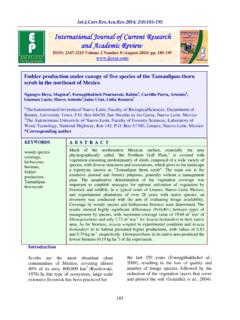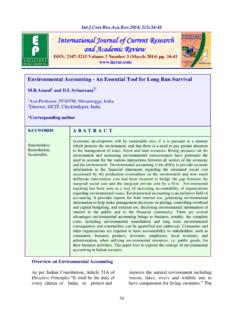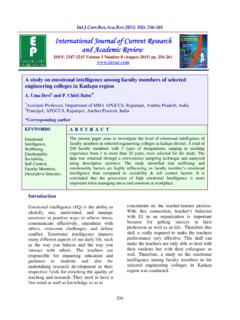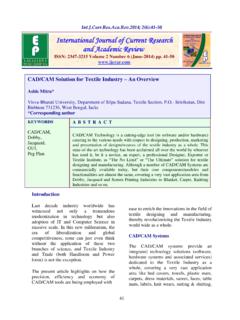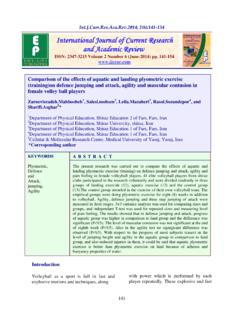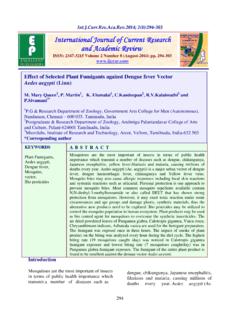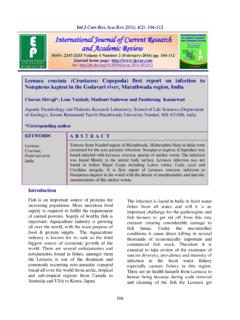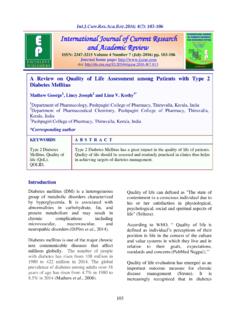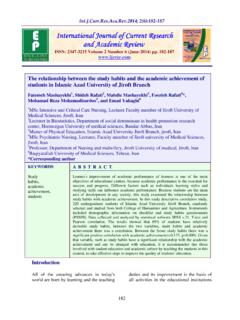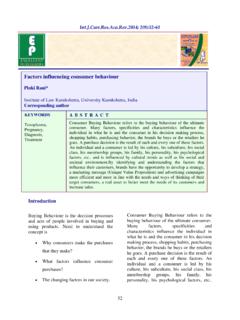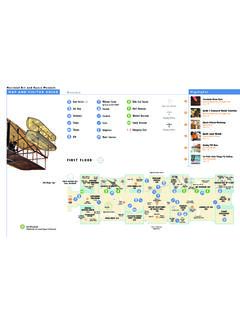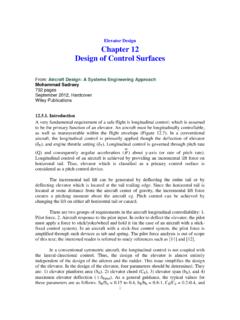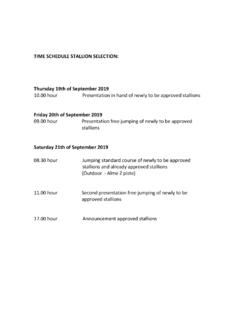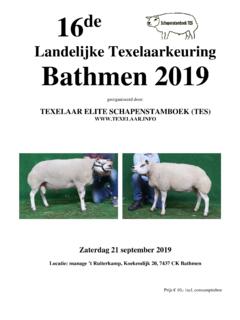Transcription of A Noisy Nutrient Induced Instability in Phytoplankton Blooms
1 ISSN: 2347-3215 Volume 3 Number 1 (January-2015) pp. 51-59. A Noisy Nutrient Induced Instability in Phytoplankton Blooms Tushar kanti Dey1, Anita Gangopadhyay2 and Gautam Gangopadhyay3*. 1. Department of Physics, Guru Charan College, Silchar - 788004, India 2. Department of Physics, Santipur College, Santipur-741404, India 3. S N Bose National Centre for Basic Sciences, JD Block, Sector III, Salt Lake City, Kolkata- 700098, India *Corresponding author KEYWORDS A B S T R A C T. Phytochemicals, The study showed the dynamics of Phytoplankton Blooms by a simple proximate, Nutrient - Phytoplankton model. A mathematical modeling with small but rapid Gmelina arborea fluctuations of Nutrient shows a major modification in the blooming scenario leaves. of the system. We have analysed the condition of bifurcation of the system by expressing the autonomous kinetic equations as Li enard oscillator which shows a very sensitivity to the noise and onset of chaos due to the bifurcation condition of the system Introduction Phytoplankton plants are mostly every year, but we shall consider only those microscopic in size and unicellular Phytoplankton Blooms which are sporadic (Edwards and Brindly, 1999; Pal and both in time and space.)
2 It is seen that there Choudhury, 2014). It is observed that may be rapid and massive bloom of Phytoplankton grows rapidly in water, , Phytoplankton . For example, some algae lakes, rivers, oceans etc. This growth of may rise to several orders of magnitude and Phytoplankton which is termed as followed by sudden fall. We also know that Phytoplankton bloom may be seasonal or many Phytoplankton species are toxic. sporadic (Griffiths, 1939; Berman et al., Blooming of such Phytoplankton is known 1995). It is commonly believed that as Harmful Algae Blooom (HAB). zooplankton grazes this Phytoplankton to (Hallegraeff, 1993; Anderson et al., 2008). control their population. There are many So a rapid rise in their population may affect models based on Nutrient - Phytoplankton - other species , zooplankton and fish as zooplankton (NPZ) model (Steele and their toxins mobilize up through the food Henderson, 1981; McCauley and Murdoch, chain. It may cause human poisoning via 1987). Here we shall not discuss about the consumption of contaminated food.
3 Control Phytoplankton bloom which occurs regularly of the blooming of Phytoplankton is possible 51. in various ways. We can consider The Bottom Up Model zooplankton as a grazer to control the population of Phytoplankton . It is called top- Fluctuation of Nutrient down model (Truscott and Brindley, 1994a,b). A general model which describes Nutrient - Phytoplankton growth is given by Huppert et Also we can say that virus Induced mortality al., (2004). (Beltrami and Carroll, 1994) can control Phytoplankton bloom. The third option is that the control of Nutrient can check the Phytoplankton population. Such type of model is known as bottom-up model (Obrien, 1974; Hupperta et al., 2005) where concentration of nutrients control the where the variable N describes the initiation and demise of the bloom. concentration of the limiting Nutrient in units of (mg) solute (m-3) water and P the In this paper we shall consider the bottom- up model for population control of Phytoplankton . It is seen that availability of Nutrient in water causes blooming of Phytoplankton .
4 Our study is based on the fluctuation of the Nutrient concentration. We introduce a noise term in the Nutrient rate Phytoplankton biomass in units of (kg). equation and study the influence of solute (m-3). It is assumed that external fluctuation of the concentration of Nutrient Nutrient inputs flow into the system at a on the evolution of Phytoplankton . A very constant rate I in units of (mg day-1 m-3), and small change in the Nutrient concentration that the time t is measured in days. The per leads to no bloom to bloom condition. The capita Phytoplankton uptake rate of nutrients stochastic process is well described by a is governed by the function g(N), for which auxiliary Hamiltonian in the weak noise several choices are possible. The model limit. Also we show that the autonomous assumes that nutrients are lost from the kinetic equations of Nutrient and water column at the rate e(N). The function Phytoplankton can be expressed as Li enard f(P) represents the per capita mortality rate type oscillator (Ghosh and Ray, 2014).
5 We of the Phytoplankton and also assumes the have analysed the condition of bifurcation of rate at which these cells sink out of the this model. In this work we have shown the water column. nature of stability of system under the influence of noise and its effect on the We choose the function g(N) = N. In this consequent blooming. This work was case the gross uptake rate g(N)P is given by organised as follows: in section 2 we discuss the usual Lotka-Voltera bilinear term (NP). bottom-up model with the introduction of We choose e(N) = 0, , there is no loss of noise term. In section 3 we express the Nutrient . Control of Nutrient affects the kinetic equations in the Li enard form to growth of Phytoplankton . We, therefore, discuss about the bifurcation conditions of consider small but rapid fluctuation of the system. Finally in section 4 we conclude Nutrient (Ghosh and Ray, 2014) and rewrite the paper. Eqs.(1, 2) as 52. where the dynamical system was driven by where, the origin of auxiliary dynamical the weak white noise _(t) whose mean and variable pN and pP is the fluctuation of the Nutrient and Phytoplankton respectively.
6 We do a numerical analysis of the Eqns. (7. variance can be expressed as such that D 10). We take following values to do the calculations: _ = , _ = 5, I = , a = 2, b = , c = 8. The initial conditions for the 1. The fokker -Planck Equation for case of no bloom are N0 = and P0 = probability distribution function W(N, P, t) and for the bloom N0 = and P0 = , corresponding to the Langevin description here N0 and P0 are the values of N and P at Eqs.(3, 4) can be written as time t = 0. Also we use the the noise term pN (0) = 10 25 and and pP (0) = 10 25, where (0) stands for the initial time t = 0. In Figure 1 we draw the nullclines dN/dt = 0. (dashed curve) and dP/dt = 0 (solid curve). The intersections of P-nullcline and N- nullcline give the equilibrium point. In our analysis we introduce a noise term (t) and we have seen that the system is very In weak noise limit LtD 0, W(N, P, t) can sensitive to this noise. The phaseplot (Fig. 2). be described by a WKB approximation of and Phytoplankton plot (Fig.)
7 3) are similar the fokker Planck equation (6) of the form to that obtained by Huppert et al (Huppert et W(N, P, t) = W0(N, P, t) exp[S(N, P, t)/D]. al., 2004). But here we do an analysis with Here W0 is a prefactor and S(N, P, t) is the the introduction of a noise term and observe classical action satisfying Hamilton Jacobi that the system is very sensitive to the noise. equation which can be solved by auxiliary Hamilton s equation of motion With the choice of the noise term which is 10 25, we found that the system do not get enough time to reach the equilibrium. In order that the system reaches the equilibrium the noise term should be as low as 10 90. If the value of the noise is larger than this, the system gets uncontrolled before it reaches where we have written the mortality rate the equilibrium state which is represented by function (Huppert et al., 2004) the dark circle in Figure 2. We can say that fluctuation of the Nutrient concentration has measureable effect on the evolution of the system.
8 If the fluctuation is large the system does not reach the equilibrium state. The auxiliary Hamiltonian is given by We also draw curves (Figures 4, 5) by varying different parameters keeping the condition of bloom , N(0) = and P(0). = Also we take pN(0) = pP (0) =. 53. 10 25. These curves are drawn to show that Nutrient and found that the system is very though the concentration of Nutrient satisfies sensitive to the noise. In order to explain this the blooming condition, there may not be type behavior we try to find out whether the any bloom. The other parameters must have system allow any bifurcation or not. Here the correct value so that there is a bloom. we shall show that the kinetic Eqns. (1, 2). Table 1 gives a list of values of the can be described as Li enard oscillator parameters which shows that bloom is (Ghosh and Ray, 2014; Messias and possible for the right choice of the different Messias, 1995). parameters. The dashed curve is drawn with values N(0) = , which is the condition of Here we define the following linear no bloom.
9 It is included here to compare transformations as with other curves of no bloom. Also the blue dot-dashed curve is drawn with value of u = (1 + I) N, z = N + P (14). N(0) = , which is the condition of bloom. such that Sensitive dependence of noise in Phytoplankton Blooms z = u (15). We draw the time evolution of the noise This transformation allows the reverse set as terms pN and pP (Figure 6). Here we have taken the initial value of pN(0) = pP (0) =. 10 25. They show small value for some follows: time but after t 8 both the noises grow Following Eqs (14) (16) we obtain the abruptly. Also the evolution of Phytoplankton shows abrupt rise after t = 11. (Figure 7). These curves show that noise affects the system. In the next chapter we do a bifurcation analysis of the autonomous kinetic equations to show the dependence of equation for z as noise. Bifurcation Analysis The steady states zs are given by the solution of the following equation The autonomous kinetic Eqns. (1, 2) are two coupled nonlinear equations relating the dependence of Phytoplankton on Nutrient .
10 We are trying to study the evolution Introducing the perturbation variable _ as (z Phytoplankton by varying the concentration zs) we finally obtain the following of Nutrient and other parameters. In section equation (2) we study the evolution of Nutrient by introducing a small but rapid fluctuation of 54. Substituting the values a = 2, b = , c = 8, In conclusion, we studied the bloom of _ = , _ = 5, I = we get the real root Phytoplankton using bottom-up model. In of zs to be and the corresponding this study the introduction of noise in the value of F(0, 0) = That is F(0, 0) kinetic equation shows that the system is < 0. So the system satisfies bifurcation very sensitive to the noise. For large value condition (Ghosh and Ray, 2014). of noise the system does not reach the Bifurcations are defined as abrupt change in equilibrium. Actually the noise itself grows the phase portrait due to a change of the rapidly with time which causes a chaos in parameter (Hubbard and West, 1995). First the system.
